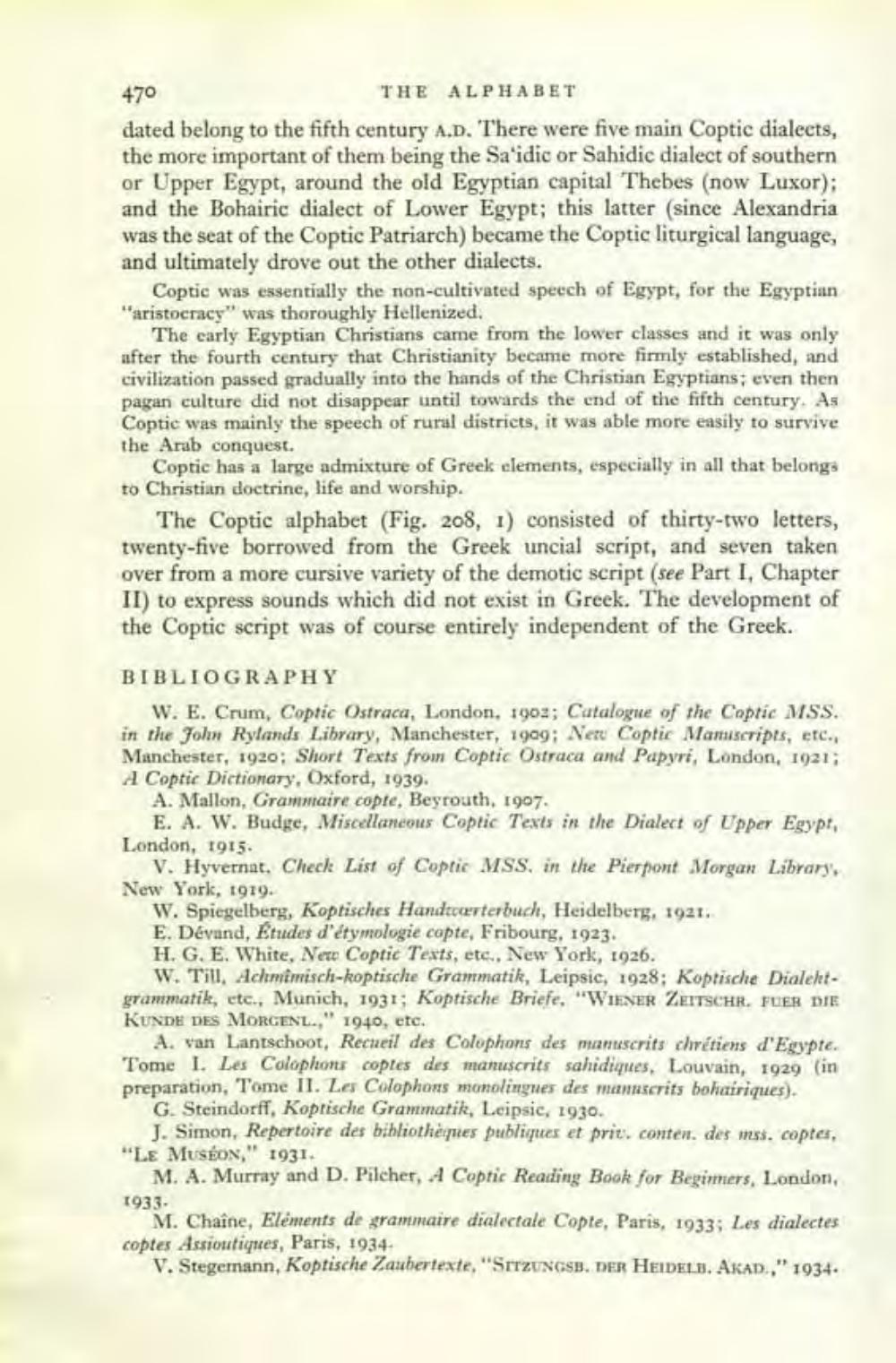________________
470
THE ALPHABET dated belong to the fifth century A.D. There were five main Coptic dialects, the more important of them being the Sa'idic or Sahidic dialect of southern or Upper Egypt, around the old Egyptian capital Thebes (now Luxor); and the Bohairic dialect of Lower Egypt; this latter (since Alexandria was the seat of the Coptic Patriarch) became the Coptic liturgical language, and ultimately drove out the other dialects.
Coptic was essentially the non-cultivated speech of Egypt, for the Egyptian "aristocracy" was thoroughly Hellenized.
The early Egyptian Christians carne from the lower classes and it was only after the fourth century that Christianity became more firmly established, and civilization passed gradually into the hands of the Christian Egyptians; even then pagan culture did not disappear until towards the end of the fifth century. As Coptic was mainly the speech of rural districts, it was able more easily to survive the Arab conquest.
Coptic has a large admixture of Greek elements, especially in all that belongs to Christian doctrine, life and worship.
The Coptic alphabet (Fig. 208, 1) consisted of thirty-two letters, twenty-five borrowed from the Greek uncial script, and seven taken over from a more cursive variety of the demotic script (see Part 1, Chapter II) to express sounds which did not exist in Greek. The development of the Coptic script was of course entirely independent of the Greek.
BIBLIOGRAPHY
W. E. Crum, Coptic Ostraca, London, 1902; Catalogne of the Coptic MSS. in the John Rylands Library, Manchester, gag; Nez Coptic Manuscripts, etc., Manchester, 1920: Short Texts from Coptic Ostraca and Papyri, London, 1921; A Coptic Dictionary. Oxford, 1939.
A. Mallon, Grammaire copre, Beyrouth, 1907
E. A. W. Budge, Miscellaneous Coptic Texts in the Dialect of Upper Egypt, London, 1913
V. Hyvernat. Check List of Coptic MSS, in the Pierpont Morgan Library, New York, 1919.
W. Spiegelberg, Koptisches Handtcarterbuch, Heidelberg, 1921. E. Devand, Etudes d'étymologie copte, Fribourg, 1923. H. G. E. White, Neto Coptic Texts, etc., New York, 1926.
W. Till, Achmimisch-koptische Grammatik, Leipsie, 1928; Koptische Dialehtgrammatik, etc., Munich, 1931; Koptische Briefe, "WIENER ZEITSCHR, FUER DIE KUNDE DES MORGENL., 1940, etc.
A. van Lantschoot, Recueil des Colophons des manuscrits chrétiens d'Egypte. Tome I. Les Colophons coples des manuscrits sahidiques, Louvain, 1929 (in preparation, Tome II. Las Colophons monolingues des mamanscrits bohairiques).
G. Steindorff, Koprische Grammatik, Leipsic, 1930.
J. Simon, Repertoire des bibliothèmes publiques et prix. conten, des mss. coptes, "LE MUSÉON," 1931.
M. A. Murray and D. Pilcher, A Coptic Reading Book for Beginners, London, 1933.
M. Chaîne, Elements de grammaire dialectale Copte, Paris, 1933; Les dialectes coptes Assioutiques, Paris, 1934
V. Stegemann, Koptische Zaubertexte, "SITZUNGSB, DER HEIDELB. AKAD.," 1934.




